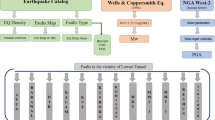Abstract
Directives from the Hon’ble Supreme Court of India led to the banning of mining activities within a radius of 2 km of the Sri Jambunatheswara ancient temple in Hospet taluk of Karnataka State of India. On recommendation of the Department of Archaeology & Museums, Government of Karnataka, CSIR-CIMFR undertook extensive investigations wherein the ground vibration and air overpressure due to blasting in nearby iron ore mines were monitored to assess their damage and annoyance potentials. The magnitudes of blast-induced ground vibration and air-overpressure recorded in the temple were found to be within the standard safe limits stipulated by the Directorate General of Mines Safety, India when trial blasts were carried out at a distance greater than 290 m from the temple. When blasts were conducted at a distance of beyond 845 m from the temple, neither vibration nor sound of blasting could be recorded or heard at the temple premises, indicating it a safe zone for blasting. After thorough analyses of the recorded data, precise blast design parameters were recommended for blasting at distances beyond 200 m from the temple and allowing this distance to be demarcated as the safe zone where controlled blasting could ensure safety of the ancient temple.

















Similar content being viewed by others
References
CIMFR Interim Technical Report (2011) Determination of safe blasting parameters to avoid damage to Jambunatheswara Temple situated near Hospet, Karnataka, Project no. CNP/3048/2011-12, November, p 93
DGMS (Tech) S&T Circular No. 7 of 1997, Damage to the structures due to blast induced ground vibration in the mining areas. Directorate General of Mines Safety, Dhanbad, pp 9–12
Jimeno CL, Jimeno EL, Carcedo FJA (1995) Drilling and blasting of rocks. Balkema, Rotterdam, p 391
JKSimBlast Software (2011) Comprehensive software package, Soft-Blast Pty. Ltd., Queensland
Pal Roy P, Verma HK, Pandey Y (2014) Mechanical mining near world heritage site—important issues. In: Proceedings of international symposium on environmental management and current practices in mining and allied industries, EMPM-2014, 13–15 Feb 2014, IIT BHU, Varanasi, pp 577–589
Acknowledgments
The authors are thankful to Sri Narayan K Bhagat, Technical Officer, CSIR-CIMFR for participating in the field study and Sri Kanai Lal Bandopadhyay, Scientist (Ex), CSIR-CIMFR for editorial help. They are grateful to the members of the Committee constituted by the Hon’ble Supreme Court of India for referring the study to CSIR-CIMFR. Munificent cooperation received from the officials of the Department of Archaeology & Museums, Government of Karnataka; Director of Mines Safety, Bellary Region; Archaeological Survey of India and the Mine Management of the concerned mines are also gratefully acknowledged.
Author information
Authors and Affiliations
Corresponding author
Rights and permissions
About this article
Cite this article
Pal Roy, P., Sawmliana, C. & Singh, R.K. Safety Concerns of Ancient Temple due to Blasting in Adjacent Mines. Geotech Geol Eng 34, 901–909 (2016). https://doi.org/10.1007/s10706-016-0013-y
Received:
Accepted:
Published:
Issue Date:
DOI: https://doi.org/10.1007/s10706-016-0013-y




